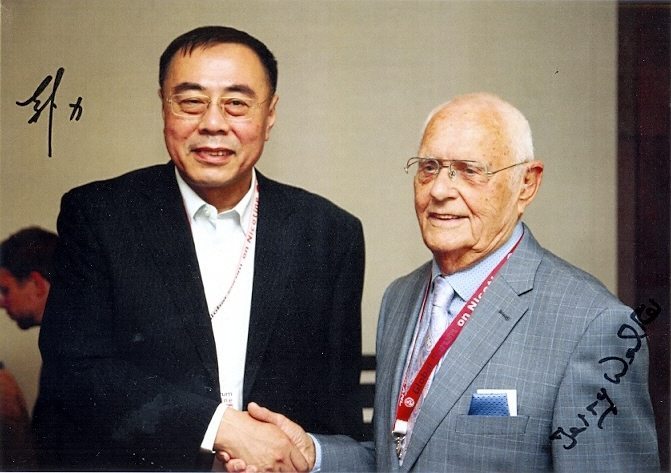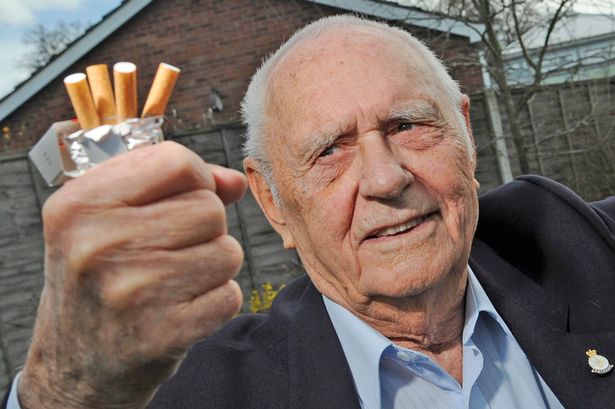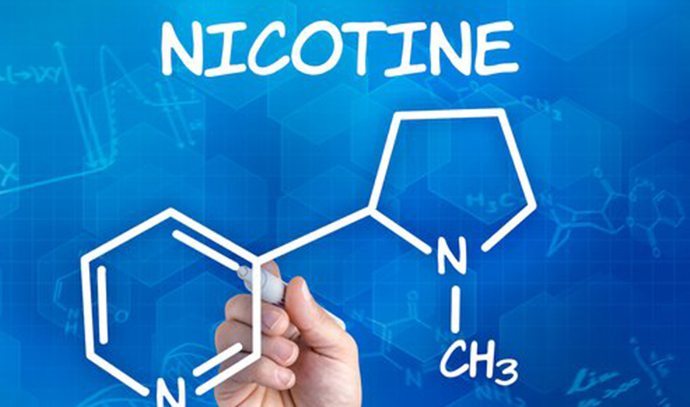Is Nicotine Really The Reason We Vape And Just How Dangerous Is It?
I’ve said it before but Terry Walker is an inspiration to us all.
After 69 years of smoking harsh none filtered cigarettes he was able to quit smoking by vaping and has never felt healthier or fitter.
So much so he began a one man crusade to convince others of the benefits of e-cigarettes with a constant stream of letters to national newspapers extolling the virtues of the vape and has submitted a plethora of scientific evidence based papers to relevant medical – scientific and governmental bodies.
His hard work was recognized late last year when the New Nicotine Alliance made him an Associate – richly deserved indeed.

2017 was an amazing year for octogenarian vaper Terry who not only attended the Global Forum on Nicotine in Poland – but had the chance to meet his ‘hero’ Hon Lik the true inventor of the modern day e-cigarette.
He’s recently submitted a couple of papers to the Science and Technology Committee – an ongoing investigation into e-cigarettes by the UK Government.
Apart from all that he still finds time for two of his favourite pastimes – ocean cruises and ballroom dancing – which is one of his absolute passions!
Like I’ve said before – he puts folks half his age to shame such is his boundless energy and commitment to helping others.
As a former scientist Terry has taken a keen interest in not only the scientific side of vaping and vape devices but also the politics and his latest paper tackles the tricky subject of nicotine.
Nicotine is known as the ‘bad boy’ when it comes to both smoking and vaping and whilst it is addictive very many scientists have proven it has the same effect on the human body as caffeine from tea – coffee and fizzy drinks.
Indeed many scientists recognize nicotine as a positive given its stimulant – relaxing – easing of tensions and sharpening of the brain functions.
So when it comes to vaping are we vaping just for the nicotine or is that only a small part of the reasons why?
Let’s see what Terry has to say:
Nicotine Reflections By Terry Walker
After smoking strong, unfiltered cigarettes for 69 years, I traded vaping for smoking 6 years ago & wrote my first paper on the subject entitled “Smoking and the Use of the Electronic Cigarette.”
One of first things I did was to attempt to identify the various elements responsible for the pleasure I enjoyed when smoking.
This is the list:
- 1/ the aroma when first opening a new pack.
- 2/ the act of handling and holding the cigarette.
- 3/ the taste of the smoke when it is inhaled.
- 4/ the nicotine “hit” felt by the throat.
- 5/ the aftertaste which lingers for quite some time.
- 6/ the oral satisfaction of a cigarette between the lips.
- 7/ the most enjoyable smoke being at the conclusion of a good meal.
Recently I have reconsidered this list and feel that the various elements should have been weighted according to their importance in delivering pleasure.
These “pleasure factors” can be divided into three parts. RITUAL, NICOTINE and TASTE.
RITUAL
I calculate that during my 69 years of my smoking life I had repeated the ritual habit of handling cigarettes on about a quarter of a million occasions and wondered what effect that experience would have had on the psyche?
How deeply ingrained have these movements become?
Perhaps a behavioural analyst could shed light on this aspect.
Turning to item 6, could this be a throw-back to babyhood?, when we derived much comfort from the use of a dummy, or pacifier?
The ritual aspect is not merely the hand to mouth action but the whole rigmarole of smoking, involving the purchase of cigarettes, means of ignition, smoking at various times of the day, viz, almost mandatory with a drink, ensuring one does not run out and always having a supply on your person at all times.
These considerations become very important in a smokers everyday living.
NICOTINE
Whilst an E-cigarette adequately deals with elements 2-7, the general feeling is that item 4 is overarching in importance, due to its addictive nature.
During the 70s & 80s, Public Health and Anti-smoking lobbies bound nicotine addiction and cigarettes tightly together to hammer home the message of the harm caused by smoking.
This association may blur the potential for “cleaner” nicotine products which lure smokers away from cigarettes.
Some studies show nicotine, like caffeine to have a positive effect as a stimulant and relaxant, which raises the heart rate, increasing the sensory information processing, easing tension and sharpening the brain.
Early on I found that a concentration of 18 mg/l N satisfied my smoking habit and used this strength consistently over the next five years of vaping.
More recently I have been reviewing my thoughts on the smoking habit and questioning the importance of nicotine and its addictive nature.
This led me to carry out an experiment in which I ordered cartomizers of various nicotine concentrations.
On arrival I used one of each strength (Viz. 18 mg N), 12mg N, 6mg N. & 0mg N), for about 20 puffs each during the same day.
Surprisingly, they all gave satisfaction but with a tiny question mark hanging over 0mg N.
That led me to deduce that the addictive nature of nicotine has been highly exaggerated as the prime reason for long term smoking and should be described more as dependency rather than addiction.
TASTE
Items 3 & 5 are all about taste, which the Oxford Dictionary tells us, is “the sensation of flavour perceived in the mouth and throat on contact with a substance”.
I believe this to be an extremely important sense.
Whatever we choose to put into our bodies, via the mouth, must pass the “taste test” in order to give the most pleasure.
Ask yourself why you drink a particular brand of coffee, type of wine, cheese or jam?
In fact any consumer product.
We all have individual preferences which have been chosen following experimentation, and smoking is no different.
CONCLUSIONS
The above thoughts lead me to believe that the taste and ritual elements are more important, than any addictive nicotine considerations.
When smoking is broken down into these elements it becomes much easier to understand why vaping is such a more effective method of stopping smoking than the use of nicotine patches/sprays etc.
Whilst the latter supply the body with nicotine, they do so at a much slower speed and fail to replicate the whole smoking taste and ritual.
The electronic cigarette, unlike a tobacco one, for the first time, allows one to tailor the nicotine content to one’s precise requirement.
A vaper does not feel that he has irrevocably given up smoking but has merely exchanged one cigarette for a much safer alternative.
Which leads me to question if Nicotine is the driving force behind smoking?
And my answer would be NO.
I fully believe that TASTE is by far the most important factor followed by RITUAL with NICOTINE being placed third.
In algebraic form;
Smoking Pleasure = xT +yR + zN (where x,y,&z are constants, whose sum = 1) & T=-taste, R =ritual, N =nicotine
I have not included my own values for the constants as I did not wish to influence thoughts of readers.
I welcome feedback on this hypothesis and it would be helpful if vapers, and other interested parties send me their ideas on the values they would attribute to the constants in the above equation.
I believe this could prove an interesting exercise, the results of which, given sufficient support, could be reported back in the New Nicotine Alliance regular e-mail.
Has Terry Hit The Nicotine Nail On The Head?
Terry’s paper actually marries beautifully with the findings of the British Psychological Society who recently gave their support to e-cigarettes as a healthier alternative to smoking.
They say:
Smoking is a behaviour influenced by a wide range of factors including nicotine addiction and psychological factors such as expectancies, beliefs, drives, motives and impulses as well as sensory components and aspects of the behaviour itself (e.g. holding the cigarette, feeling the smoke in the mouth and throat, or to facilitate social interaction).
Cigarette smoking delivers a high level of nicotine to the brain very quickly (10–20 sec), an effect which immediately activates the brain chemical, dopamine.Because other stimuli [e.g. the handling of the cigarette, the ‘catch’ of smoke in the throat] are associated with this effect of nicotine, they too can become pleasurable in their own right, contributing to smoking addiction.
Not sure if Terry’s read that report but he can add ‘vaping psychologist‘ to his already impressive CV!
You only have to look at the average vaper that moves to sub-ohm vaping after time to see this idea really does stand up to scrutiny.
How many of us began on 20mg nicotine and above but as we vaped for longer it was US that decided to reduce the levels of nicotine we vape with and NOT any nannying government or over zealous health official.
Hands up how many of you NOW vape 3mg or even zero!

So whilst nicotine is a factor in why we vape – it is indeed just part of the reason as explained by Terry and indeed the British Psychological Society.
We’d like to thank Terry very much for sharing this with us and he’d really like to hear your thoughts and opinions on this:
Please help me to get my message out there as I am keen to know what other vapers, including yourself, feel regarding why people smoke and the influence of nicotine.
I am trying to find out what other vapers feel about why we smoked and which elements were responsible for the pleasure derived and the degree to which each element provided that pleasure.
I feel we have been misled regarding the role of nicotine and the contribution it is responsible for.
Since learning how vaping improved my health, some 6 years ago I have made many attempts to “educate” the medical fraternity by sharing my experiences.
I have written to Chief Medical officer for UK, World Health Organisation, Minister of Health, Public Health England, NICE, Action on Smoking and Health and more recently provided written evidence to the Select Committee of Science and Technology.
I now feel that the tide has turned and like to think my efforts have been fruitful judging by the groundswell of positive feedback from the medics.
Some 3 years ago I felt that the culmination of my efforts would be the provision of e-cigarettes on NHS prescription within 6 years. Although many laughed at this idea, it is now being examined in earnest by the NHS.
For me, the battle is almost over and feel it is perhaps time to wind down my efforts at my age in favour of younger and more qualified scientists.
Wow…just wow…
So come on the younger generation over to you please support Terry by leaving a comment below OR email him at tlw9 [at] gotadsl.co.uk
And Terry I know you’ve been poorly recently – get well soon and take care of yourself mate – you’ve got more ocean cruises and dancing to do yet my friend and if anyone deserves them you do!









Thanks for sharing an interesting article like this. I started my vaping on 16 mg nicotine and of fruity flavor e-juice. Ecig helps me lessen my nicotine intake up to 3mg and hoping to not put nicotine anymore one day. Terry is a great person and an inspiration.
For forty years, I smoked a pack of cigarettes a day and when I was stressed I smoked more, so I believe there is an element of the pacifier in them. However, for the last ten years of smoking, I hated the taste of cigarettes and always had to suck a sweet with them to take the taste away. So, it was very easy for me to switch completely to vaping on the day I was introduced to it via cigalikes. However, I disliked the replica tobacco taste and the terrible battery life, so it was a bit of a chore, but a week later I went online to see if there were any alternatives and that’s when I found the amazing vaping forums and the scientific research, which I’ve followed for the last five years.
I ordered a couple of generation 2 ecigs, a Provari, some tanks and some delicious sweet and dessert flavoured eliquids; they made such a difference, it was a pleasure to vape and I’ve never looked back or so much as wanted a cigarette since. In fact, after a couple of weeks of exclusive vaping, I decided to smoke my remaining two cigarettes, but the taste was so putrid, bitter and harsh, after one puff, I nearly gagged and had to put it out.
To me, “addiction” is a behaviour that you are compelled to pursue despite bad or harmful consequences. With vaping, I started on 24mg/ml but after a while, it suddenly felt too strong for me and I was forced to reduce it, which I did in 6mg/ml increments each time it happened, down to 6mg/ml, without even noticing the difference – that isn’t addiction! Although I could easily have reduced to 0mg, I’ve stayed at 6mg/ml and am considering going up to 9mg/ml because of the cognitive benefits of nicotine.
I also read about Dr. Paul Newhouse and his work and I strongly believe nicotine has more benefits and barely any harms, if any, at the quantities that vapers use and that it may be mildly dependence forming at most, but it certainly isn’t addictive and there are no studies proving that nicotine is addictive. I’ve read a number of times that MAOIs and possibly other additives in cigarettes are the cause of the addiction and of course, the habit of reaching for a cigarette and the ritual around it, is very deeply ingrained and satisfying, a major element that ecigs address but NRT doesn’t. Some people are more susceptible to addiction than others, which is why I believe some are able to quit smoking without much, if any, help.
I know I have an addictive personality, so I stay away from gambling; a behaviour the causes some people immense harm, despite the fact that it doesn’t have a chemical aiding the addiction.
Public Health and Tobacco Control are very tightly bound with the pharma industry and receive a great deal of funding from them and in return, they incessantly peddle their various NRTs; all the while keeping smoking in the public’s eye, including each new generation of young smokers, despite the fact that the tobacco industry aren’t allowed to advertise themselves. When I was smoking, I tried numerous times to quit using various NRTs and failed miserably everytime; throughout I craved cigarettes and there was certainly no pleasure to be had from them. In fact they even tell us that we can expect to fail numerous times. Once I started researching vaping, I found out that NRT has a 93-98.2% failure rate.
When it was released onto the market 30 years ago, PH/TC ramped up the messages that nicotine is highly addictive, more addictive than heroin in order to keep people buying it, despite failing with it time after time. We believed it was our addiction that was the problem, not the crap product. They desperately need us to believe that nicotine is highly addictive in order to keep their highly lucrative smoke/NRT/smoke cycle going and pharma want to keep their nicotine market to themselves, together with their treatments for so called ‘smoking related diseases’.
Smokers self reinforce these addiction messages daily but, frankly, if it was more addictive than heroin, NRT wouldn’t be allowed and easily accessible on supermarket shelves in lovely flavours and you wouldn’t have been able to buy litres of 72mg/ml over the counter for decades. It would be prescription only, which is ridiculous. Having told so many lies for so long, it’s very difficult for PH/TC to backtrack or admit the truth and they have a massive conflict of interest with all their funding coming off the back of interested parties ~ tobacco companies, pharma companies and governments. However, thanks to vaping, the truth is finally coming out and I look forward to the day they are defunded!
I fully agree with Terry; for me too, the order of importance is ~ Taste ~ Ritual ~ Nicotine
Chris Price has written a good deal about nicotine on his website Ecigarette Politics http://www.ecigarette-politics.com/
I agree with Terry totally. I too have been thinking about the role of nicotine in vaping, and have done some cursory research recently. Almost 4 years ago, I instantly stopped an almost-a-pack-a-day smoking habit after almost 40 years, starting at 12mg nicotine. I’ve gradually decreased that level to 3mg. I don’t have any plans to go lower, partly because I enjoy the throat “hit” and partly because of the current research being done on the beneficial effect nicotine has on Parkinson’s and Alzheimer’s diseases. However, I have noticed that vaping has less of a grip on me than smoking had; I can sit through an entire concert without feeling the necessity of going outside at intermission for a smoke, for example!
In the Canadian government’s current campaign to “control” vaping, I’ve heard the litany “nicotine is highly, highly addictive”, “even one puff can lead to addiction”, “more addictive than heroin” frompoliticians, public health officials, and even Health Canada – the official government department. This made less and less sense, given my experience, so I did some searching and found the work of Vanderbilt University’s Dr Paul Newhouse — he concluded quite some time ago that nicotine is not very addictive on its own.
As part of his current research, he prescribed pharmaceutical grade nicotine (i.e., without all the chemicals in tobacco cigarettes) to a group of non-smokers for several months. Not one of them developed an addiction. In fact, this research led to the FDA approving over-the-counter purchase of nicotine patches and gum. (Public Health bodies issue a convoluted pseudo-scientific explanation involving the speed with which the nicotine is absorbed into the body — I can’t follow it very well, so I assume it’s an attempt to blind people with science.)
My current quandary is: Why are the people charged with public health still chanting this addiction chorus? I can understand the politicians — they get their information from public health — but educated professionals in the field should be aware of the reality. Part of me says that public health is ruled by the pharmaceutical industry, and that may be the answer.
If you have any more knowledge than I have, I’d be happy if you shared it. I’ve started trying to educate some Canadian politicians and hope that I’m on the right track!